One of the biggest attractions when traveling to Berlin is to take a tour of Potsdam.
tour to Potsdam
. For Berliners, this city is the usual escape from the hustle and bustle of the capital. Only 30 km southwest of Berlin is the former residence of the Prussian kings and German kaisers until the beginning of the 20th century. If you have to visit Berlin in 3 days, reserve one for this tour to Potsdam.
In this getaway we will feel like kings!
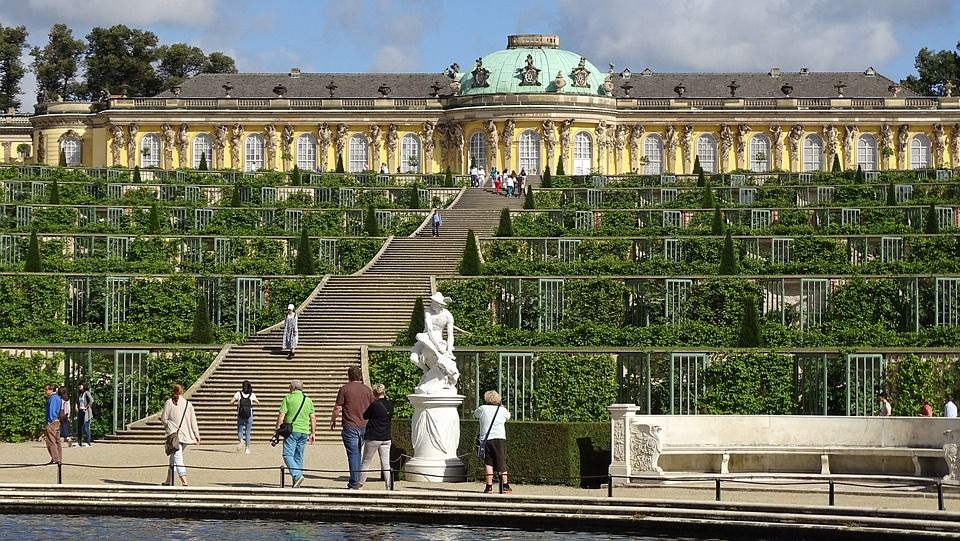
Sanssouci Palace Potsdam http://bit.ly/vermilinguos
The most convenient is a
guided tour to Potsdam in English
You will have to make transfers and take different types of transport.
If you prefer to go on your own, you should take the suburban train no. S7(SBahn).
We start our route in WannSee
During the train ride we will be able to see Berlin and its surroundings. Our first stop will be WannSee, where we will take bus 316 to enjoy, from its second floor, a panoramic view of this beautiful lake. Along the Havel River many lakes are formed but this is the most important one. It was here that one of the darkest episodes of contemporary Germany took place.
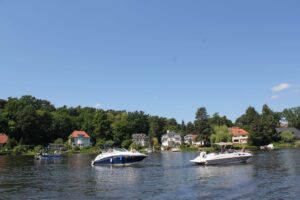
Berlin WannSee
The Wannsee conference took place in a Villa where “the final solution of the Jewish question” was planned.
For the Jewish people there were always two Adolfs. SS Lieutenant Colonel Adolf Eichmann was the so-called “face of the Holocaust”. He was one of those in charge, together with Reinhard Heydrich (of Jewish origin), of approving at this conference the immediate future for the Jewish people.
The Bridge of Spies
We will get off at the stop“Glienicker Brücke” or GlienickeBridge. We are going to see one of the most famous bridges of the cold war. It divided West Berlin and the German Democratic Republic (GDR) and became a frequent scene of exchange of spies imprisoned between the two Germanies. For the GDR it was also a source of economic income, as they often exchanged American spies for money.
The press re-baptized it as the “bridge of the spies”.
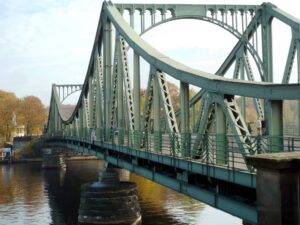
Glienicker Brücke or “Bridge of Spies”.
This location can be found in many James Bond movies or in the Tom Hanks movie of the same name. We leave you below a video, with a part of our tour of Potsdam, with our partner Jacobo:
Now we will cross the bridge taking advantage of the fact that nowadays there is no need to make any kind of exchange 😛
At the end of the section we will see a map that shows us where the Berlin Wall used to pass, which also used the river as a separation.
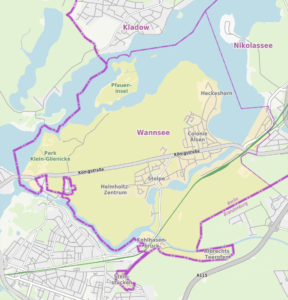
The Berlin Wall in Potsdam
Cecilienhof Palace
On the right hand side you will find the entrance to the Neuer Garten park.
The entire complex was declared a World Heritage Site by UNESCO in 1990.
Wilhelm II had the last Hohenzollern residence built in this garden: the Cecilienhof for the crown prince.
With a style similar to an English country house (Tudor), made of brick and wood. It was built between 1914 and 1917. Unfortunately, Prince William was only able to live there for one year, as he accompanied his father into exile after the First World War. Cecilia, his wife, would stay there until the Red Army took Berlin in 1945.
At the end of World War II, the heads of state of the Allied countries would meet there for the famous Potsdam Conference, where the future of Germany and Europe would be decided.
Be sure to stop by its inner courtyard, where you will find a huge souvenir of communist Germany at the request of Stalin himself!

Cecilienhof Palace
We leave these enchanted gardens and take a 603 bus to the center of Potsdam,
we head towards the “Holländisches Viertel” or Dutch quarter of Potsdam.
Holländisches Viertel
The Dutch were brought in by Frederick I for technical reasons. These were professionals in water abstraction and the adaptation of marshlands such as Berlin and Potsdam. They settled there, forming a hundred buildings typical of the Netherlands, with red brick and sloping roofs. One of the most important Dutch neighborhoods outside its own country.
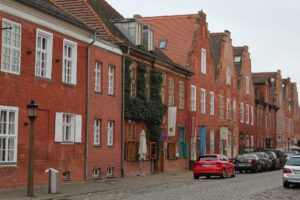
Dutch quarter of Potsdam Photo: http://bit.ly/vermilinguos
We continue walking and pass very close to the Nauener Tor (German: Nauen Gate). One of the three preserved gates in the city of Potsdam, Germany. Rebuilt after the bombings of World War II.

The Nauener Tor in Potsdam Photo: http://bit.ly/vermilinguos
At last we reach the city’s axis, Brandenburger Straße. This pedestrian street is ideal to stop for a snack or a drink.
With its exclusive stores and gastronomic offerings, it is the perfect place to sit on a terrace and enjoy the atmosphere of the city of Potsdam.
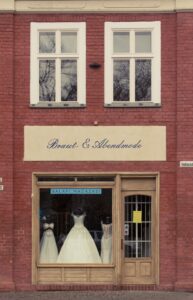
Potsdam Shop Photo: http://bit.ly/vermilinguos
At the beginning of the street we will see the Catholic church of San Pedro and San Pablo, of Romanesque style with Byzantine touches. We recommend a visit inside to see the altar.

Brandenburger Str. with the Church of St. Peter and St. Paul in the background. Photo: http://bit.ly/vermilinguos
In a straight line, we will see the Brandenburg Gate (Postam’s) on the other side 😀
Built by Frederick II “the Great” in 1770 to celebrate Prussia’s victory in the “Seven Years’ War” against the Austrian Empire. Each side of the gate has been designed by a different architect and for many years it was the only gateway to Brandenburg, hence its name.
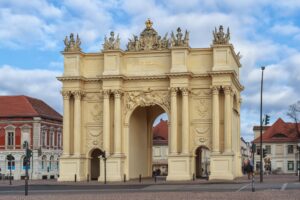
Brandenburg Gate in Potsdam
We will leave through this door, as everyone did in the old days, and go to see the most precious jewel of Potsdam: Sanssouci.
Sanssouci Palace and Gardens
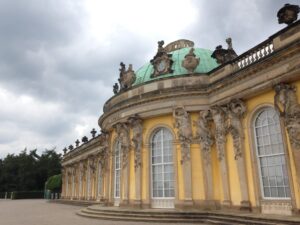
Sanssouci Palace
Church of Peace
Before going to the gardens we will make a quick stop at the beautiful Church of Peace. William IV ordered the construction of this Protestant church, an almost exact copy of the church of San Clemente in Rome, where the most beautiful things are kept inside. On the altar a precious Venetian mosaic of the 13th century on the apse adorns the interior of the church. Below the sanctuary is the royal chapel, with the tombs of Frederick William and his wife Elisabeth Ludovika.
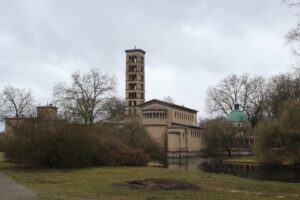
Peace Church Photo: http://bit.ly/vermilinguos
Sansoucci Palace
We go out into the gardens and see the Sansoussi Palace from afar. Frederick II “The Great” was an enlightened monarch who loved the trends coming from France. He did not hesitate for a second to turn his residence into his own “Versailles”. Sanssouci (French for “carefree”) is a UNESCO World Heritage Site of parks, gardens, palaces and mansions. Built between 1745 and 1747, the palace stands out for its ornate rococo style and its baroque and romantic gardens.

Sanssouci Palace Potsdam Photo: http://bit.ly/vermilinguos
When it was built, his wife, Isabella Christina of Brunswick-Bevern, said that there was no room for a woman in Sansoucci.
Much has been said about the sexual orientation of the monarch and his friendships. Voltaire, his close friend, stayed there for three years until they had a disagreement and he returned to France. During his years in Sansoucci Frederick II wrote, composed and played the flute; gathering in private parties the most illustrious minds of the royal house.
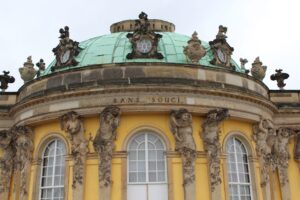
Sanssouci Palace Potsdam Photo: http://bit.ly/vermilinguos
After his death, the monarch asked to be buried in a plot annexed to the palace, in a sober and unnoticed manner. There lies his body and that of his 12 dogs that accompanied him in life and death.
Above the tomb of Frederick II we will always find potatoes, a curious way of thanking the monarch for the introduction of this food in the former Prussia.
Passing to the other side of the building we will see on top of a hill a cistern, which was used to supply water to the fountains, and the “Ruinenberg” or mountain of ruins. These Roman ruins are not authentic, they were brought by Frederick II to give an even more neoclassical air to the environment. An escape from what was often thought to be the tormented private life of the king himself.

“Ruinenberg” or mountain of ruins.
At the exit of the Palace there is a windmill from the same period, although it had to be rebuilt, where you can buy homemade bread. It is said that the monarch did not destroy it to make the people understand that the king was not above the law that prevented it.
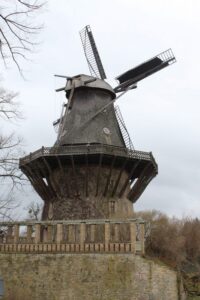
Potsdam Mill Photo: http://bit.ly/vermilinguos
And with this last anecdote we end our tour of Potsdam!
We will take the bus back to the train station that will take us back to Berlin.
You will have seen that it is worth visiting Potsdam in one day. Don’t miss the opportunity to enjoy this beautiful city and its unique and incomparable stories.
To reserve a place in our guided tours click on the following link:
https://culturetouringberlin.com/tour-potsdam-espanol/
See you soon!


